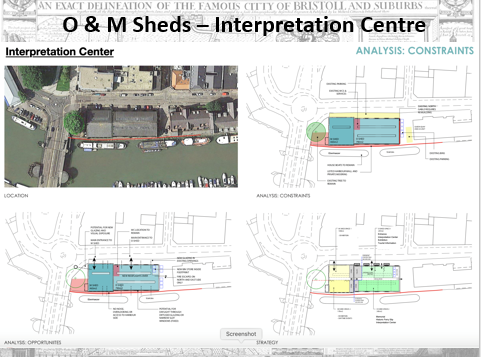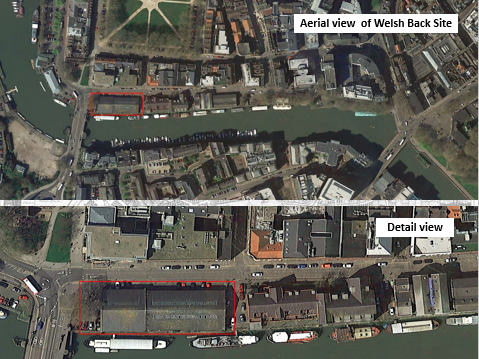
A Vision for O & M Sheds, Welsh Back, Bristol
Subsequently sold to a developer
Introduction
Bristol has played a key role in events, ideas and literature that have shaped people’s freedom and parliamentary reform. Previously these topics have been neglected because they don’t quite fit the national narrative. The narrative has to change for the 21st Century. Bristol can lead the way. For a fleeting moment there’s a golden opportunity to make it happen; a vital retelling of the role Bristol has played on the world stage.
Currently lying empty, O & M Sheds are awaiting redevelopment and strategically positioned exactly where this 1,000 year history happened; Wulfstan and Clarkson investigating the slave trade 700 years apart, the epicentre of the 1831 Reform Riots, the start of radical literature Robinson Crusoe, Gulliver’s Travels and Treasure Island.
Concept
Local residents have come up with the superb idea of a History Hub. Due to the unique history of this area the idea has developed into a scheme to create a much needed memorial to the victims of the slave trade and a visitor centre/museum. Three rooms each dedicated to its own related and inter-related topic; one large Abolition Room and two smaller rooms for Reform and, through Robert Louis Stevenson, the part played by ideas, art and literature. A spur to other related visual arts and beliefs.

Location
The last undeveloped part of Bristol’s historic Floating Harbour, O & M Sheds are on the quayside at Welsh Back, between Queen Square and the river Avon, adjacent to Redcliff Bridge and on the Brunel Mile from Temple Meads to Millennium Square. The sheds are positioned either side of locations ‘C’ & ‘D’ of the Treasure Island Trail which takes people from historic King Street to M Shed and are in the perfect place to enhance the ‘String of Pearls’ of visitor attractions along the dockside.
Nowhere else in the world can offer this combination of history and locale.
Connections
For Abolition we can connect with London, Liverpool, Glasgow, Nantes (France), the West Coast of Africa, Antigua, Barbados, Jamaica, Nevis, St Kitts and the US.
For Reform Birmingham, Derby, Nottingham and Peterloo, Manchester.
For Stevenson, partners in the European Cultural Route ‘In Stevenson’s Footsteps’ [RLS ECR]); connecting with others in Scotland, France, Belgium, Germany, Switzerland and ultimately the US, Hawaii and Samoa.
Significance
Historical
Just yards away, and by preaching every Sunday for months on end, St Wulfstan got the 400 year old slave trade between Bristol and Dublin banned in 1090. In the 12th Century king Henry II used resumption in this trade to seize Ireland.
From these very quaysides Bristol merchants led the way with exploration of the new world from the 15th Century and dallied with the African slave trade from as early as the 16th Century.
In the 17th Century ‘legal’ access was gained to the African trade. From the 1640’s non-conformists such as Baptists and Quakers spoke out against slavery in all of its forms, including a ‘Blackymore Maide’ named Francis who actually hailed from Welsh Back. Many were persecuted and made great sacrifices.
Early in the 18th Century Bristol pirates and privateers inspired the works of Defoe and Swift; abandonment, pro and anti-colonialism respectively. They also inspired Robert Louis Stevenson to explore topics such as duality (good and bad in John Silver and Dr Jekyll) and kidnapping. The creation of literature’s first ever Treasure Map in King Street.
The late 18th Century saw the growth of anti-slavery sentiment through John Wesley and Thomas Clarkson, both of whom had valuable local assistance. This led directly to Abolition of the slave-trade throughout the British Empire in 1807 and emancipation in 1838.
Finally, there was Parliamentary reform, culminating in the Queen Square Reform Riots of 1831 where many hundreds of Bristolians were killed and wounded by the military.
Emancipation eventually happened because of three things coming together: –
- Slave rebellions
- The abolition movement in Britain
- Parliamentary Reform (pro-slavery MP’s losing their seats)
Emotional
A long overdue memorial to the victims of slavery so that people can remember and reflect, contemplate and heal – on the quayside adjacent to the old Redcliff Ferry slipway in full view of King William’s statue in the centre of Queen Square. Additional sight lines from Bristol Bridge, Redcliff Bridge and across the water from the Exploration sculpture – near the Seven Stars pub where Clarkson was based.
A sculpture of literature’s greatest anti-hero, Long John Silver, with his mixed-heritage wife outside their Bristol pub the Spy-Glass (reckoned to be the nearby Hole-in-the-Wall).
Educational
A learning centre for children and adults, schools and universities, locals and visitors, acknowledging Bristol’s development and the actions of all its citizens; previously, currently and in the future.
History Hub
A working party of Destination Bristol, Bristol City Museums Archives and Libraries and local community groups led by the Long John Silver Trust (RLS ECR), Welsh Back Association, Counter Colston and Bristol Radical History Group [BRHG] coming together and making this extremely valuable resource happen for Bristol.
Conference, exhibition and meeting space for shows, events and community usage. Interactive, internet and external interconnected displays (G5 infrastructure, see ‘Bristol is Open’) with outdoor activities such as historic walking tours.
Funding and Future
Grant funding applications made by all four community groups inside the Collective.
The Slavery Memorial should be treated on its own and perhaps made the subject of an international competition to find a suitably sensitive and stunning design.
We need to rely on the knowledge and expertise of Bristol City Councils Museums, Archives and Libraries. Once in place it is proposed that the Abolition Shed project adopts the economic model currently employed by the SS Great Britain.
“The cause of Abolition was the world’s first great Human Rights Campaign.” – Adam Hochschild